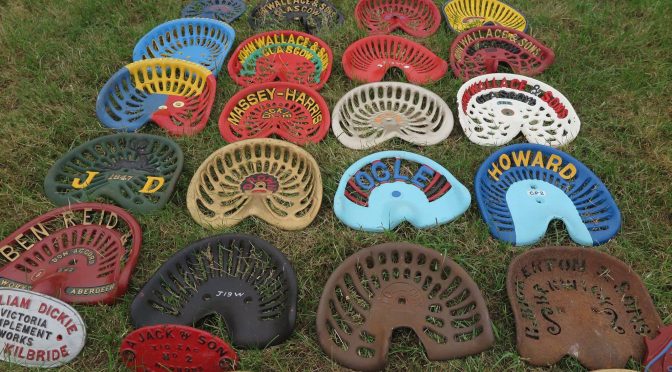Accounts of the Highland Show are helpful in describing in great detail the implements and machines that were available to the Scottish farmer in any particular year. Some of the older accounts were especially detailed. The national press carried extensive and detailed accounts. They were written by their agricultural correspondent who had a great deal of knowledge of agriculture and its implements and machines. They knew what was innovative, what developments had been made and what was of note for the Scottish farmer.
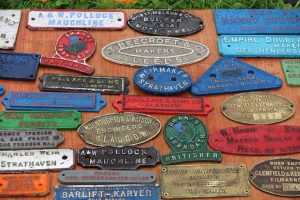
The following is an account of implements and machines at the Highland Show from the Scotsman in July 1875.
“The display of implements is the largest ever held under the auspices of the Society-the catalogues showing 2220 entries, as against 1344 at the last Glasgow show, 900 at Edinburgh in 1869, and 1161 at Inverness last year. Of novelties in agricultural machinery there are comparatively few; but many improvements are shown in the most important implements of husbandry, calculated to have an effect a saving in the wear and tear of horses, or to render the machines themselves more durable-both important matters, especially to the smaller class of farmers. A notable feature in the exhibition-and it is one which has been gradually but surely assuming large proportions-is the number, not only of American inventions for the saving of labour in the economy of the farm, but of other goods manufactured in America, and offered here at prices equally low with those of home construction. For a time this kind of competition was confined, for the most part, to reaping and mowing machinery, but now we find neatly and tastefully made haymakers, spades, turnip-slicers, &c, apparently of solid workmanship, offered at rates sometimes lower than those demanded by British manufacturers. On the present occasion, as in former shows, there are many articles exposed for inspection, and, we suppose, sale, which are connected with agriculture only in a remote degree. Such are the sausage-machines and sewing machines, the washing and golfering machines, and a score of other domestic knick-knacks, which command a large share of attention, especially from blooming country lasses and buxom matrons, expectant or actual mistresses of goodly “farm touns”. Fortunate exhibitors in the other sections of the show will no doubt find their account in making a selection from the elegant silver cups and medals displayed on the stand of Mr James Aitchison, Edinburgh, silversmith to the Society. The stand is an attractive one in every sense of the term, the valuable goods being disposed in ebony and gilt cases, with plate-glass fronts. The Auto-Pneumative Gas Machine Company exhibit a set of their apparatus for making gas. The machine consists of a cylinder, which is partly filled with the spirit called gasoline, distilled from mineral oil. In the interior is a pair of fanners, which draw in atmospheric air and thoroughly mix it with the vapour of the gasoline. The supply of the gas thus simply made being regulated by the consumption and by a system of weights which form the motive power in driving the fanners. The gas burns with great brilliancy, and has no offensive smell, and the apparatus, one would suppose, must prove a great boon in isolated farmhouses and mansions. Dobbie & Forbes, Glasgow, exhibit a series of new kitchen ranges; but of more interest to the bucolic mind are the very handy portable boilers for preparing and steaming feeding stuffs for cattle. These are built on light carriages, and can be run into stables and byres, thus effecting a great saving of labour at a time of the day when that will be most welcomed in a steading.
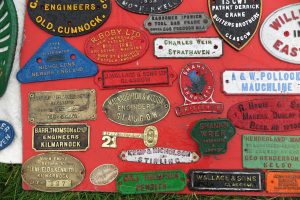
To the farmer now-adays artificial manures are an important matter for consideration, enabling him, as they do, to raise crops commensurate with the high rents demanded. Not the least important stand in the yard, therefore, to the enterprising agriculturalist, is that of W. & H. M. Goulding (Limited), Dublin and Cork. Here are displayed in neat cases specimens of bones in a variety of prepared forms, corn and grass manures, and superphosphate of lime, an element in the soil whose necessity for raising profitable crops is now being fully recognized. The raw materials from which these manures are manufactured are also shown; while specimens of agricultural produce grown with the assistance of the manures are tastefully arranged as a background to the cases. Among the latter samples are pease eight feet high from Dumbartonshire, wheat and oats six feet high from the Earl of Claremont’s farm at Castle Bellingham, Louth; mangolds from Lord James Butler’s farm at Drumcandra Castle; turnips from the Marquis of Bute’s home farm. A useful thing on all farms where so much iron-work is subjected to constant breakages is a handy forge; and the portable forges exhibited by Andrew Handyside & Co. (Limited), Glasgow and London, seem well adapted to casual work. The leading feature in the stand of Harrison, McGregor & Co., of Leigh, are the mowing and reaping machines. These show improvements in the shape of a malleable iron mowing shoe, with steel plate, which prevents wear in rough ground, and an arrangement for tipping the points of the fingers of the knife bar when these encounter stones. The same firm shows a large collection of chaff cutters and turnip slicers of neat and sound workmanship. James Henderson & Co., Glasgow, exhibit a large collection of waggonettes, landans, omnibuses, and broughams, fitted with patent spring balance and improved lever drags. Considering that by the recent heavy rains some crops must be considerably laid, farmers will examine with special interest an apparatus for lifting the corn to the reaping machines exhibited by Mr A. Hughes, Brampton Ash. This lifter being screwed on to the knife-bar and hung on a steel spring, raises the corn to the knife by means of steel pointed fingers. Glasgow may be considered the centre of an extensive dairy district; and accordingly the yard would have been incomplete without an exhibition of dairy utensils. Mr A. Jenkinson, Princes’ Street, Edinburgh, has, on one of the largest and most elegant stands in the yard, an assortment of tidy milk pans, coolers &c, in china and stone-ware. As a set off to these useful articles, he has arranged a series of handsome table decorations, in Minton, Worcester, Sevres, Chelsea, and Dresden china, comprising swans, cupids, and boats on mirror lakes.
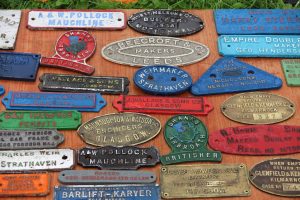
But perhaps the most important part of the stand is that devoted to the exhibition of a new Scottish industry-the Valerie pottery made at Dunmore. This manufacture was established by the Earl of Dunmore on his estate about eighteen months ago, and during the past year a great advance has been made in the quality of the articles produced. In addition to the brown glazed ware which became so fashionable, they have succeeded in securing various fine tints of green and blue; while designs in the form of rustic baskets for flowers, tea sets for garden parties, &c, have been furnished by the Countess of Dunmore, who, with her noble husband, takes great interest in the pottery. Macnie & Baird, engineers, Stirling, exhibit, among other articles, a “feed water heater”, invented by Mr Robert Baird, which utilises the exhaust steam of an engine in heating the water up to 212 deg. Before it enters the boiler. The result, of course, would be a great economy in fuel. As regards extent of ground occupied, the stand of Francis Morton & Co. (Limited), Liverpool, is about the largest in the yard, and here are displayed specimens of the wire and bar fencing with which the name of that firm has been so largely identified. The novelties embrace an opening stile, consisting of two firm iron pillars, which, on touching a spring in the crown of one of them, fall apart so as to admit of the passage of one person at a time. Portable iron hay and corn barns deserve attention in this uncertain season, and so do corrugated iron tiles, for use on agricultural buildings where clay tiles are not made and slates are not to be had.
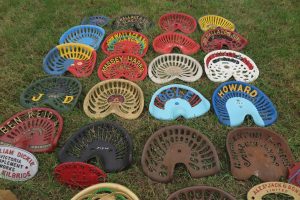
The principal new agricultural invention to be seen in the yard is Jurgenson’s weeder, exhibited by Ord & Maddison, Darlington. This machine is designed to destroy the weeds which grow amongst corn, such as the yellow mustard, which has proved so troublesome in some parts of the Lothians this year. It is just possible to destroy these weeds without injuring the crop, because the weeds arrive at maturity before the corn. Hitherto hand hoeing has been considered the only safe method. Mr Jurgenson’s invention consists of a horizontal cylindrical drum, hung upon two wheels much in the same way as a reaping-machine. Another new invention, exhibited by Penney & Co. (Limited), Lincoln, consists of an adjustable rotary corn-screen, with a metallic cleaner in lieu of a brush. Should this cleaner not bruise the grain, it can hardly fail to prove a great saving to farmers in dressing corn for the market or for seed. Mr John Richardson, Carlisle, has long been famous for his dressing appliances, and here he exhibits various patterns of improved winnowing and combined corn and seed-dressing machines. On the stand of John G. Rollins & Co., London, may be found an extensive assortment of American agricultural implements. A glance at these shows their extreme lightness combined with strength at all the wearing parts. The Hollingsorth horse rake, for instance, seems well worthy of notice. The machine has some twenty-five compound spring teeth, the upper parts of which play upon a spiral spring, thus preventing any strain on the machine when the teeth are caught upon a stone or stump. Then there are specimens of American hand rakes, hay and manure forks, and pumps of the most ingenious and simple construction. The thermometer churns afford a certain index to the dairymaid, in summer and winter, of the temperature of the milk to be churned, and guide her in adding to the outer casing cold or hot water, as the case may be, in order to bring the milk up to the proper degree of heat. Samuelson & Co., Banbury, have brought out a combined mower and reaper, specially adapted to the hilly land of Scotland, the improvement upon their old machine being a “leading wheel”, which bears the weight of the pole, and thus relieves the horses in going uphill. Mr Wm Sinton, Jedburgh, exhibits a large variety of his now well-known barrel churns, and Thomas & Taylor, Manchester, a collection of hexagon-eccentric churns.
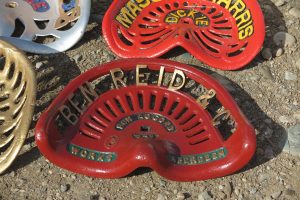
In the section of “implements partly under cover” there are some fourteen stands, for the most part containing articles of a lighter description. Perhaps the most imposing display, numerically speaking, is that of Thomas Gibson & Son, Edinburgh. Variety is one of the chief features of this stand, which shows plain and ornamental wirework, iron gates of all descriptions, horse rakes and garden appurtenances. Those interested in matters pertaining to the laundry will find something attractive in the stand of Mr William McFarlane, Cambridge Street, Glasgow. Here are wringing machines, with improvements for preventing injury to the clothes; while mangles presenting some new features are also shown. The well-known northern makers, G. W, Murray & Company, Banff, have, as usual, a large display of ploughs and reaping machines. In addition to these, their stand presents a novelty in the shape of threshers which can either be worked by horse power or by hand, and which seem likely to prove useful machines. This firm also has a new chain pump for horse power, which appears capable of advantageously lifting large quantities of water, and which we believe is being successfully used on the Nile for irrigation purposes. It is in chaff cutters that Messrs Picksley, Sims & Co (limited), Lancashire, present a novelty. These machines differ from the kind now generally in use, in so far as they are fitted with patent recessed side plates and solid rollers, and double-cut and reverse-motion gear, while the feed is regulated by springs instead of lever weights. A well contrived double-action hay-making machine is shown by Mr Adam L. Pringle, Edinburgh and Kelso. This is the patent of Joseph le Butt, and comprises a slow and fast motion, so that it can be used for long and short grass, while it can also be lowered for the spreading of dung. Richmond & Chandler, Salford, Manchester, have a number of chaff-cutters, varying in size from the small hand machine to such as can be driven by horse or steam power. Articles for the culinary department abound in the collection of Smith & Wellstood, Glasgow, London and Dublin, along with farm boilers and kitchen ranges of the most recent construction. This firm exhibits a new patent pressure water heater capable of being connected to the kitchen range, or other boiler, for supplying warm water throughout the house for bath and other purposes.
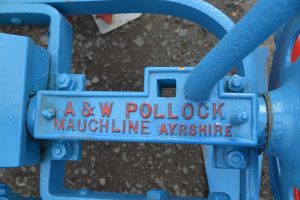
As might be expected, the “implements not under cover” occupy a large proportion of the ground. At the stand occupied by Richard Bickerton & Sons, Berwick on Tweed, several reapers and mowers, with some features of novelty, are to be found. There is also a machine for the thinning of double drills or turnips. It is worked by a small wheel to which are attached a couple of suspended arms, intended to move from left to right across the top of the drills. A conspicuous display of fire-clay goods and drain-pipes is exhibited by Robert Brown & Son, Paisley, besides a variety of other implements, Mr James P. Cathcart, Ayr and Glasgow, shows a one-horse combined mower and reaper, made by W. A. Wood. This machine, which gained the first prize at Renfrew a few days ago, is of strong and simple construction, and seems well adapted for small farms. Prominent in the collection of Mr Willaim Craig, Old Meldrum, is a self-side delivery reaper, the invention of Mr G. T. Yull. The main wheel of the machine shows no gearing or spur wheel; the bevel pinion is separately placed on the inside, driving the rakes direct, as well as securing a horizontal throw of the knife, and avoiding all jolting and knocking, while the ears are prevented from being cut off, and the height is regulated by the driver. Something like a couple of hundred garden and farm appliances, all of them more or less known, are exhibited by P. & R. Fleming & Co., Argyll Street, Glasgow. The two firms of George Gray & Co., and John Gray & Co., Uddingston, are, as usual, large exhibitors of ploughs, grubbers, harrows &c. Attention is invited by Haughton & Thompson, Carlisle, to several improvements on their mowers, reapers, and rakes. Mr Charles hay, North Merchiston House, Edinburgh, shows a potato planter and digger, which are both new and ingenious in design. In the stand adjoining, Richard Hornby & Sons, Ironworks, Grantham, have a number of self-raking reaping machines, ploughs &c. Mr Wm Hume, Buchanan Street, Glasgow, occupies a considerable space with iron and wire fencing, ornamental iron fencing, &c. Mr Thomas Hunter, Maybole, shows numerous double-drill turnip thinning machines, potato digger, land rollers, turnip cleaners, brake and zig zag harrows &c in addition to a new turnip-lifting machine, which appears to possess some advantages over the ordinary implement.
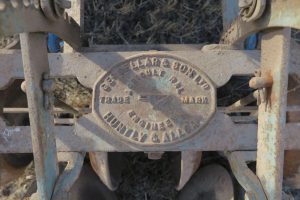
In the collection of Alex Jack & Sons, Maybole, is a self-acting side-delivery reaper, which has been improved by making the platform more convenient for traveling. The stand presents a variety of useful agricultural implements, amongst which figure largely the “Buckeye” combined reaping and mowing machine, and Messr Jack also show a rather nice cart, spring van, and light lorry. Murray & Nicholson, Stirling, come next with a somewhat similar collection, embracing, among other things, an improvement which has bee made on their “Waverley” reaper and mower. Mr William Lillie, Tweedmouth, Berick on Tweed, shows two improved “Imperial” reaping and mowing machines, and a horse grubber and hay collector, as also a newly-invented “disc” harrow and a “disc” turnip sower. Logan & Elder, Tweedside Implement Works, Berwick on Tweed, exhibit their reaping and mowing machines with patent spring washers for taking shake off nuts; also a very good double drill turnip and mangold sower, which differs from most other machines of the kind in the mode of delivering the seed, and is adapted to sow eight different quantities of turnip seed, besides rape, mangold, and carrots. Geo McCartney & Co., Cumnock, have a neat double-sole cheese press, with screw and screw wheels, a lever with index, and a friction strap to prevent breakage. On the next stand we encounter a new portable automatic hay drier, invented and made by Mr W. A. Gibbs, and shown by Mr henry Macdowall, yr, of Garthland, Lochwinnoch. The hay is placed in the opposite end of the drier in a furnace for heating air, which is carried up through a duct in the centre. The hay is placed at the opposite end from the furnace, and by means of forks and an oscilating floor it moves along the whole length of the dryer, receiving in its way the benefit of the heated air which is allowed to escape from the central duct. The dryer can be worked either by an engine or a pair of horses. A large variety of useful and ornamental fencing, in wire, is shown by A. & J. Main & Co., Scott Street. Port Dundas, Glasgow, as also a self-delivery reaper, horse rakes, double furrow plough, corn mill, &c. Robert Mitchell & Son, Peterhead, exhibit a turnip drill-sowing machine, which possesses the advantage that it distributes an equal quantity of seed, whether the boxes be full or nearly empty. It is of slight construction, and suitable for light land. The same firm also show a newly invented corn drill, eight feet wide, which sows with four, six, and eight inches between the rows. Mr Jas Pattison, Darnley Mill, Hurlet, Glasgow, has two simple but ingenious articles, the one a sleigh for collecting, building, carrying, and discharging ricks of hay, and the other a wagon to carry and deliver loads of hay without the use of the fork or the necessity of upsetting the load.
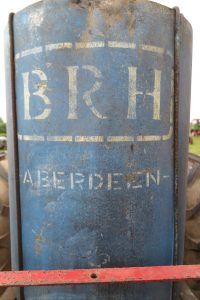
Robert Peddie & Co., Tynecastle Ironworks, Edinburgh, have a miscellaneous collection, including park and field gates and pillars in wrought iron, harrows, ploughs, turnip-sowers &c; while T. Pirie & Co., Kinmundy, Longside, Aberdeenshire, show some novelties in self-delivery reaping machines and mowers and reapers; also a three-horse grubber, with twisted cast-steel breasts to prevent choking, and an adjustable turnip thinner. Ben Reid & Co., Bon Accord Works, Aberdeen, in a large collection of articles, exhibit the well-known “Kirby” mowing and reaping machine, comprising the Kirby self-delivery combined machine. These machines are peculiar in construction, being formed of two independent frames, one of which acts upon the other freely, giving an easy motion over rough ground. Mr John Scoular, Crook Implement Works, Stirling, has several brake harrows, the advantage of which consists in their diagonal shape, each time cutting its own rut. Geo. Sellar & Son, Huntly, have a goodly assortment of useful implements, including a rather ingenious five-furrow stripper, which saves both time and labour, and which gained a medal at the Aberdeen Show on Thursday last. Eglinton Engine Works, Glasgow, send a number of cart, platform, and sack weighing machines; while Somerville & Morrison, exhibit waterproof covers, roof felting, packing tarpaulin, &c. P. & W. McLellan, Glasgow, show three improved rock drilling machines, which appear to be not only portable but ingenious and useful; and Mr Marsden, Soho Foundry, Leeds, exhibits two of Blake Marsden’s stone-breakers, mounted on wheels, besides a double-action lever machine for hand power. Robey & Co., Lincoln, show several engines, noticeably amongst which is a twelve horse power double cylinder horizontal engine and locomotive boiler combined, with an enlarged fire box for burning sawdust and refuse wood.”
A very broad selection indeed!
